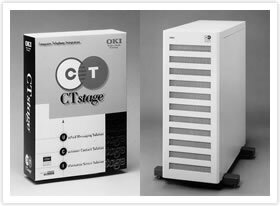Part 17
Part 17: The Trajectory of the Market-Leading Call Center System
Call centers serve as important points of contact between businesses and customers. The functions required of a call center—increasing customer satisfaction, contributing to sales, and providing customer-oriented marketing—continue to grow in sophistication and complexity. In response, OKI developed CTstage in 1996. Today, CTstage boasts the leading market share of all call center systems. The product fully embodies the unified messaging concept, integrating a wide range of media, including voice, fax, and email.
The unified messaging concept
Around the middle of the 1990s, paralleling the rapid growth of Internet use, the term multimedia emerged as a key buzzword. Naturally, OKI engineers, who had ceaselessly tackled the challenges posed by the latest technologies, grew increasingly interested in giving concrete expression to the multimedia concept in the form of a product.
This was the backdrop for OKI's efforts to develop CTstage. CTstage was designed as a multimedia-oriented product, one that would increase office efficiency by integrating the traditional core of telephone and fax communications with the expanding medium of email, whose use had spread from large enterprises to small and mid-sized enterprises.
Development began with a question: Just what is multimedia? In Japan at the time, few products embodied the concept of multimedia, making it hard to grasp just what the concept referred to. In the United States, multimedia-compatible computer telephony integration (CTI) services were already in the process of being established. A group of UnPBX products had begun to appear. CTstage project team members got their start by learning from these developments.
The concept that emerged was that of unified messaging: using computers to achieve integrated management of various communication modes, making it possible to access information, even across media. The team members targeted nothing less than a revolution in office communications.
Pursuit of individuality through an open platform
What about hardware? This was the first question to confront the project team. If OKI were to begin developing all the hardware it needed in-house, they realized, the product could not be released on time. The development team feared being left behind by global trends. Their solution was to use effective products already released and available, where possible.
While this decision itself might seem simple, it was a harsh verdict for hardware engineers who had assumed OKI would do its development in-house. It was precisely this openness to new ideas, free of hidebound adherence to a tradition of in-house development, that allowed OKI to introduce CTstage.
One hardware issue was selecting hardware capable of handling voice and fax communications. The CTI field at the time revolved around the U.S. market. Numerous telephony boards designed to send and receive voice and fax data had already been introduced. The mainstream consisted of input/output boards compatible with the Industry Standard Architecture (ISA) bus for Windows NT. The products from the various companies were generally free of significant differences in functions, although various architectures jostled for position in the emerging market. The focus was on identifying and employing an architecture that would become the mainstream. Following repeated discussions, the team chose a product with worldwide market share. This openness to new ideas and to a multi-vendor orientation took various forms.
We continue to see this approach in today's CTstage. OKI secures market advantages through a product development approach that prioritizes speed of development, market potential, and cost performance.
Realizing simple customization through an open API

CTstage made its debut in 1996. About three months later, OKI began shipping products in the CTI intranet series. The product initially shipped only in the form of embedded versions. Shipment as a standalone software package began with CTstage Ver. 1.1. From these beginnings, CTstage has continued to evolve to the present day.
One distinguishing feature of the CTstage series, which adopts a client-server model, is its open application program interface (API). An API is the set of programming procedures specified for software on a certain platform. An API makes it possible for users to develop custom applications. While some previous CTI products had used APIs, OKI's CTstage was the only product to provide not only interfaces for telecommunications lines, but a broad-ranging API covering the functions needed for applications development. It went on to win high regard as a system for call center and office communications, applications for which customization is essential.
CTstage passed through various subsequent development milestones, including the addition of broadband IP compatibility, IP telephony compatibility, and strengthened security, as it established its position as the leading call center system in terms of market share.
